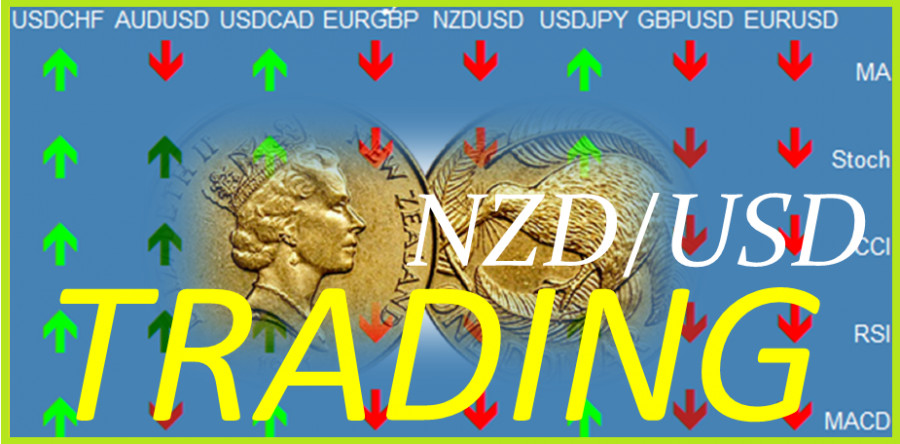NZD/USD refers to reverse currency pairs and indicates how many units of the US dollar (the national currency of the United States) must be paid for one New Zealand dollar (the national currency of New Zealand). The base currency of the NZD/USD pair is the New Zealand dollar. This means that the commodity in the NZD/USD pair is the New Zealand dollar, and the US dollar is the second currency in the pair, which buys the base currency (New Zealand dollar). The New Zealand dollar, unlike the US dollar, is not included in the IMF's basket of five major world reserve currencies: US dollar, euro, yuan, yen, and pound sterling. However, the NZD/USD pair belongs to the category of "major" currency pairs along with the USD/JPY, EUR/USD, GBP/USD, USD/CHF, USD/CAD, and AUD/USD.
At the moment (at the beginning of June 2022), the NZD/USD pair is trading on the Forex market near the 0.6230 mark. This means that for one New Zealand dollar they give 0.6230 US dollars.
Features of trading the NZD/USD pair
1. Both the US dollar and the New Zealand Dollar are highly liquid currencies. At almost any moment, there will be both buyers and sellers for the US dollar or the New Zealand dollar. New Zealand belongs to the countries with a steadily developing economy. The GDP growth rate of New Zealand before the coronavirus pandemic fluctuated near the level of 3.0% per year.
2. The New Zealand dollar, along with the Canadian and Australian dollars, has the status of a commodity currency. The dynamics of prices for agricultural products, meat and dairy, and woodworking complexes has a strong impact on the quotes of the New Zealand dollar. Once every two weeks, an auction of dairy products is held on the Global Dairy Trade dairy exchange (usually at 12:00 GMT). The auction results are published after 13:00 (GMT). Usually, the increase in prices for dairy products is accompanied by an increase in the value of the New Zealand currency, and the volatility in the NZD/USD pair increases sharply.
3. The most important trade and economic partners of New Zealand are China, Japan, and Australia. The publication of macroeconomic statistics from these countries directly affects the quotes of the New Zealand dollar, causing an increase in the volatility of trading on it. Important political events in the USA, New Zealand, the countries of the Asia-Pacific region, and in the world also affect currency quotes, and first of all, the US dollar and the New Zealand dollar.
4. The NZD/USD pair is actively traded throughout the trading day. The highest peak of trading activity with the New Zealand dollar and the NZD/USD pair and the largest trading volumes occur during the Asian session (00:00 – 08:00 GMT), especially at its beginning, and the American session (12:00 – 21:00 GMT).
5. A surge in trading volatility in the NZD/USD pair occurs during the publication of important macroeconomic indicators for the US and New Zealand. The following macroeconomic factors and indicators give the greatest volatility to the NZD/USD pair:
- Decisions of the Fed and the Reserve Bank of New Zealand regarding monetary policy in the United States or New Zealand,
- Speeches by the heads of the Fed and the RBNZ (currently Jerome Powell and Adrian Orr, respectively), especially if they relate to monetary policy issues,
- Publication of minutes from the latest meetings of the Federal Reserve and the RBNZ on monetary policy issues,
- Data from the labor market of the USA, New Zealand,
- Data on GDP of the USA, New Zealand,
- Publication of inflationary indicators of the USA, New Zealand.
6. Back in March 2019, the interest rate in New Zealand remained one of the highest in the world (1.75%), which attracted traders using the "carry-trade" strategy in their trading and investors looking for a stable long-term income. However, in March 2020, due to the coronavirus pandemic, the Reserve Bank of New Zealand lowered the interest rate to 0.25% and increased the scale of monetary stimulus to the maximum, signaling the possibility of negative interest rates. In this case, the difference in interest rates in the United States and New Zealand made "carry-trade" transactions relevant, when an expensive currency is bought at the expense of a cheaper one due to the difference in the profitability of investing in these currencies. In 2022, the Fed, and the RBNZ at the end of 2021, began to tighten their monetary policies due to sharply increased inflation, which reached the highest levels in several decades.
7. Selling American or New Zealand stock assets on world stock markets usually leads to an increase in the value of the US dollar or New Zealand dollar, respectively, and vice versa. The US dollar has a particularly strong inverse correlation with the dynamics of US stock indices.
8. The New Zealand dollar has a fairly strong correlation with other commodity currencies, primarily with the Australian and Canadian dollars. Accordingly, the NZD/USD pair has a significant inverse correlation with the USD/CAD pair (75%) and a direct correlation with the AUD/USD pair (95%). In relation to other "major" currency pairs, the NZD/USD pair has a different correlation, direct with EUR/USD (88%), XAU/USD (67%), GBP/USD (58%), inverse with USD/CHF (88% ), USD/JPY (64%). It is also worth noting that the degree of correlation also changes periodically, but in general it remains the same.
9. The NZD/USD pair is a "technical" pair and has fairly even volatility throughout the trading day. The intraday volatility of the NZD/USD pair fluctuates during different periods of the year. On average, it is 80–90 points, but it can rise sharply during periods of publication of important macroeconomic indicators for the US or New Zealand.



















